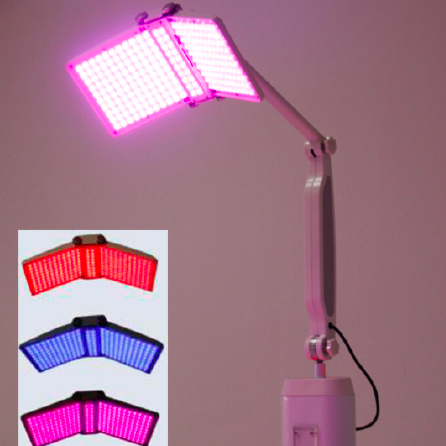What is it?
This is a treatment using non-heat emitting LED (Light Emitting Diodes). It is also known as low level laser therapy.
The wavelength of the light being used will determine the potential clinical effects on the skin including promoting collagen and thus improving wrinkles and fine lines, treating pigmentation and scars and treating acne.
How is it done?
Low intensity light emitting diodes (LED) are placed over the area to be treated and depending on which skin concerns are being addressed , the blend of light therapy wavelengths will be selected by the treating physician or nurse. The light then penetrates the skin and exerts its effect.
Treatment usually varies from 20-40min per session. It is similar to lying on a tanning bed and there is NO discomfort. Multiple treatments may be needed to achieve the desired effect.
The therapy can also be combined with other treatments such as radio frequency (RF), micro-needling or IPL to enhance the effects.
Wavelengths Used
1. Red Light (640nm) – penetrates 1-6mm and helps to increase collagen and stimulates fibroblast repair and cell growth – good for wrinkles and fine lines. It may also have some benefit in improving hair regrowth.
2. Blue Light (423nm) – penetrates 1mm and helps to reduce inflammation, inhibit sebaceous glands and destrroy P. Bacterium – the bacteria causing acne. It may also be used to activate photosensitising agents (see below)
3. Yellow Light (590nm) – penetrates 1-2mm and helps to improve microcirculation and helps to inhibit melanin and freckles.
4. Green Light (532nm) – penetrates 0.5 – 2mm and helps to speed up wound healing and lighten scars.
PDT (Phtodynamic Therapy)
This involves the initial application of a chemical called a photosensitizer to the skin – after a certain incubation period – 1-4hrs usually, a light source is applied to the skin which activates the photosensitizer. This activation in the presence of oxygen can result in the destruction of cells.
Levulan is a photosensitizing agent commonly used and can be activated typically with blue light, but also red light. This is commonly used to treat actinic keratosis – which are premalignant “sun spots”. It has also been shown to be effective at killing the bacteria that causes acne and improve inflammatory acne lesions themselves. Immediately following treatment the skin can be swollen, red and tender – resembling a sunburn. The area may crust over and peel and the lesions will slough off. You may be sensitive to the sun and will require the application of a good sunscreen (SPF 50 or more) afterwards. The benefits of this treatment are that it can be used on ALL skin types, does not involve surgery and is safe.
You may require treatments monthly until the lesions are treated and then annual maintenance treatment. We are now able to offer Tryptophan PDT in addition to the conventional PDT – please find more information on this in our services section.

